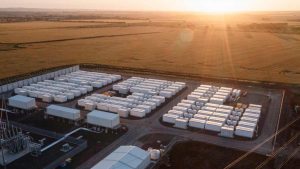Never have so many people got so excited about something so unremarkable.
Hydrogen, which makes up around three-quarters of all visible matter in the universe, is being feted by politicians, industrialists and energy experts alike as a wonder molecule that will help deliver humankind from fossil fuels. At least there is some basis for this furore.
Hydrogen 101
When created via electrolysis, using renewable or nuclear energy, or – more contentiously – via a process called steam methane reforming (SMR) combined with carbon capture and storage (CCS), hydrogen can indeed be used as a low-carbon fuel to replace oil and gas in a range of applications.
In theory, this range is rather wide. Hydrogen, currently produced using SMR without CCS, is already a major industrial chemical, used mainly to produce the ammonia that goes into fertiliser and other products.
However, this so-called grey hydrogen is also a major contributor to greenhouse gas emissions, since SMR emits significant amounts of carbon. Getting rid of the carbon, for example, through production via electrolysis or SMR with CCS, would allow ammonia to be made without emissions.
Low-carbon hydrogen (called ‘green’ if made via electrolysis with renewables, ‘pink’ if made from nuclear energy and ‘blue’ if created using SMR with CCS) could also be used in methanol to replace bunker fuels in shipping. And it could be used as a fuel and reacting agent to replace coal in metallurgy. And it could power turbines, instead of gas.

The list of potential applications for hydrogen includes prosaic uses such as powering cars – a concept that Toyota has tried to popularise with its sleek yet poorly selling Mirai sedan—and heating homes, which Northern Gas Networks in the UK is hoping to do with a project called HyDeploy.
This vast array of possibilities has got policymakers and energy nerds all worked up. Low-carbon hydrogen has almost all the usefulness of fossil fuels, with little or none of the emissions. In the decarbonised society of the future, hydrogen, rather than oil and gas, will be key to geopolitical heft.
There is much to celebrate about this picture, starting with the fact that green hydrogen will, in theory, be readily available to any nation that has access to cheap renewable energy – and the list of such nations is growing rapidly.
Furthermore, in emissions reduction terms, low-carbon hydrogen is a lifesaver for several industries that have few other options for eliminating greenhouse gases. Ammonia or steel cannot be produced at scale without fossil fuels unless hydrogen is used, for example.
Hydrogen Economics
But this importance for certain sectors, contrasted with its wide range of possible applications, could prove a problem for hydrogen. Despite all the hype around hydrogen’s decarbonising potential, almost all the hydrogen today is of the highly polluting grey variety.
And it will take a long time before green and blue hydrogen dominate the picture. Both types are currently more expensive to make than grey hydrogen, although the high price of gas is starting to give green supplies an edge in certain locations. In February, for example, steelmaker ArcelorMittal declared green hydrogen made using low-cost solar power in Spain would be able to compete with coal, oil and natural gas.
Even once economic barriers have been overcome, it will take some time before the infrastructure currently used for storing and transporting natural gas can be adapted for hydrogen. In many cases, the infrastructure for hydrogen may need to be created from scratch. On top of that, the production facilities for low-carbon hydrogen will need to scale massively from where they are today.
The European Union (EU) already uses about 9.7 million tonnes of hydrogen a year for industrial purposes. That would all have to be switched from grey to low-carbon production before any excess could be used for critical decarbonisation tasks such as reducing steelmaking emissions.
And it is a vast undertaking: just replacing those 9.7 million tonnes would require 200GW of new renewable energy capacity, or as much nuclear power as there is in the whole of France.
The ability to increase production will likely depend on advances in green hydrogen, which has traditionally been the most expensive version of the gas but is expected to be the cheapest and most scalable option in the long term.
Blue hydrogen, in contrast, will always be more expensive than fossil fuels because it relies on gas as a feedstock for SMR. And it will always be more expensive than grey hydrogen because it requires CCS to be added to the SMR process.
Nuclear power, meanwhile, could, in theory, provide round-the-clock energy for electrolysers, but the recent track record of the two newest reactors in Europe does not bode well for pink hydrogen costs and timescales. One of the reactors at Flamanville in France is more than five times over budget and a decade over schedule. The other, in Olkiluoto Island in Finland, went more than three times over budget and is 13 years over schedule.
The cost and availability of green hydrogen, meanwhile, is essentially a function of the cost and availability of electrolysers and renewable energy. In Europe, electrolyser manufacturers are currently able to build enough electrolysers to produce an estimated 1.75GW of hydrogen per year. The EU is planning to invest €27 billion in electrolysers through its REPowerEU program, but with a timeline that extends to 2027.
And in practice, scaling up low-carbon hydrogen could take up to twice as long because of limitations on the renewable energy needed to power these electrolysers.
Today’s electrolyser technology has a conversion efficiency of only around 65%, which means it takes roughly 51 kWh of electricity to produce a single kilogram of green hydrogen. If used to fuel a Mirai, this could take you roughly 200 km. But based on an average range of 6.4 km per kWh, an electric vehicle could go for more than 320 km on the same amount of electricity.
Electrolyser efficiency levels could rise to around 76% by 2050, according to the International Renewable Energy Agency. But that still means around a quarter of the electricity used for electrolysis will simply be wasted.
And this is electricity that is already needed to decarbonise energy grids and road traffic. Whether renewables can scale rapidly enough to replace existing fossil fuel generation, fuel industries such as transport and at the same time meet the needs of a burgeoning green hydrogen sector is still unclear.
The European wind energy industry body WindEurope, for one, has called on policymakers to speed up the rate of renewables deployment in pursuit of hydrogen goals, saying in June that this must become the EU’s top priority for reaching climate neutrality and breaking away from Russian fuel.
We will need significant periods of excess renewable energy to drive power prices to fractional or negative levels for extended periods to make hydrogen economics attractive for many applications. This will take several years, likely well into the next decade.
Low-carbon hydrogen’s scalability and efficiency challenges have sobering implications for how it might best be used in the energy transition. Given that climate scientists are warning we need to drastically reduce carbon emissions now, it hardly makes sense to wait a decade or so to find out if there will be enough low-carbon hydrogen for tasks such as residential heating, which can be carried out using electricity today.
Indeed, an emerging school of thought advocates a strict hierarchy of use cases for low-carbon hydrogen. Thus, applications such as fertiliser or methanol production, which cannot really be carried out at scale by any other means, should have priority in switching from fossil fuels to hydrogen.

At the other extreme, meanwhile, is a host of applications that really should not be powered by hydrogen because they can easily be carried out using electricity. These applications include power system balancing and most types of short-to-medium distance road transport, including passenger cars, urban delivery vans, two- and three-wheelers and metro trains and buses.
In some cases, such as heating, there are fears using hydrogen could be bad for climate and health. The fact that many of hydrogen’s potential use cases might not be competitive in the long term should not be a concern for investors, however. Hydrogen’s place in the energy systems of the future is pretty much assured and a hydrogen economy will deliver major returns even if the gas-only ends up being used in a fraction of the applications it is currently being touted for.
Digital Energy and the Focus on Electrification
Meanwhile, investors should focus on the bottom of the hydrogen hierarchy for another reason: this is where the next big opportunities for electrification lie. Heating, passenger mobility and road transportation can all be decarbonised using electricity now instead of waiting a decade or so for hydrogen to do the job. What is more, electrifying these sectors is a much bigger deal than it sounds.
We are already seeing the value of the digital transformation taking hold of energy production as fossil fuels are gradually replaced by renewables in the generation system. Digital-first concepts such as aggregators and virtual power plants are delivering new sources of value for investors. But an even bigger opportunity is on the horizon with the digitalisation of demand-side assets needed to enable the electrification of sectors such as transport and heating.
Alexa Capital outlined some of the likely winners in this evolution a decade ago, in a 2012 paper on the dawning of the digital energy revolution. The paper outlined eight energy-related concepts that would stand to gain from digitalisation, and the list is still as pertinent today as it was then. We highlighted:
New energy services, such as selling efficiency (net zero) consultancy and demand management. These can help regulated companies overcome a key challenge facing the move to a low-carbon society: how do you get energy providers to reduce end-user consumption when their profits depend on selling more? Carbon pricing and efficient markets are now beginning to help shape this journey.
E-infrastructure/alpha infrastructure, or investments in distributed generation assets that can maximise profits by combining negotiated power agreements with flexible merchant sales and new energy services. This investment opportunity has already gone mainstream and is set for further growth. A new category of core++ infrastructure/private equity investors is now emerging, capable of taking merchant market risks and engaging in today’s increasing volatile power markets.
Next-generation intensive power users such as data centres, water companies, electric vehicle fleet operators and food and beverage industrials and distributors, to name a few energy-intensive industrial groups, have a need for low-cost energy supplies for competitive advantage and are keen to embrace efficiency and demand response technologies to cut costs and reduce emissions.
Power electronics for low-voltage and high-voltage use cases. The former creates new opportunities in fields such as home/prosumer automation, while the latter supports more intelligent charging infrastructure, more efficient grids and demand response aggregation systems.
Efficiency and environmental technologies from LEDs and cavity insulation to building automation and smart heating, ventilation and air conditioning systems. Driven by building regulations, this is a massive and growing opportunity for private equity and credit investors as well as corporate capital flows.
Grid intelligence and capacity/constraint management, required for a move from traditional hub-and-spoke electricity networks to grids with distributed generation and smart demand response controls. Grid intelligence is critical for the energy transition, encompassing fields such as sensor technologies, data analytics, inertia control, capacity management and interconnectivity for the critical expansion of distributed renewable generation, storage and electric vehicle charging infrastructure. Learn more on our Quarterly Insight focused on Flexibility
Large-scale energy storage and flexible power peaking, incorporating assets as varied as pumped hydro, gas peakers, flywheels, capacitors and fuel cells. In practice, the most efficient and cost-effective storage option is to interconnect grids for widespread power flows and manage demand and supply with digital technology.
Hybrid systems, whether in cars (for example, in the form of regenerative breaking mechanisms or stop-start motors), homes (mixing electricity with heat pumps and solar thermal heating) or large-scale power generation (combining wind with batteries and electrolysers, for instance).
Many of these areas are already attracting major flows of capital and others are beginning to pick up speed. On the demand side in particular, progress has been slow because of a lack of pricing signals that assets can respond to, but that is changing. In the UK, for example, the proposed Future System Operator will feature five-minute pricing intervals instead of the 15-minute periods used today.
It could also use nodal or locational energy pricing, which has already been adopted in other parts of the world, as an incentive to build new generating assets in areas where they can deliver the most value. As other electricity system operators go down this route, the potential for value generation is huge. The heat pump market alone, for example, is expected to be worth $83.5 billion worldwide by 2026, rising with a compound annual growth rate of 9.5% from 2021. This is a here-and-now market, not one that will take years to mature.
All that is needed to stimulate this market are the regulatory structures to support digitalisation of energy on the demand side. That, we believe, should be just as much a priority in the short term as getting the clean hydrogen economy off the ground is in the long run.
Gerard Reid is co-founder of Alexa Capital and co-host of the Redefining Energy podcast. He can be found on Twitter at @gerardreid14










